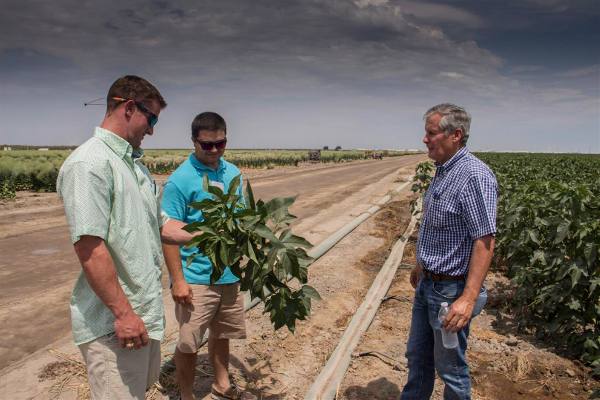
If there was one thing that struck a chord with a group of cotton growers from the southern Plains states of Texas, Oklahoma and Kansas touring California recently it was the incredible amount of regulations California farmers must deal with on a daily basis to produce food and fiber.
Hosted by the National Cotton Council, cotton growers from various regions of the United States are touring other cotton regions this summer to see what their peers are up to. Sponsored by Bayer CropScience through a grant to The Cotton Foundation, the Producer Information Exchange, or P.I.E. Program, is now in its 25th year of helping U.S. cotton producers maximize on-farm efficiency programs.
The California leg of the tour brought about a dozen growers and other industry participants to California’s San Joaquin Valley to view a variety of growing operations and hear from industry leaders on the state of agriculture in America’s leading farm state.
“This is just incredible what you all have to deal with out here,” said Susan Everett, a National Cotton Council of America member services representative based in Lubbock, Texas. “It blows my mind the regulations these guys have to deal with.”
For instance, visiting growers heard about California’s water woes and how farmers who depend on irrigation water from the California State Water Project receive a scant 20 percent of their promised allocation of water to produce crops. The result of that is no more evident than in the vast amount of fallow land tour participants saw along the western side of the San Joaquin Valley.
“Farmers in Texas wouldn’t tolerate this,” said Donald Kirksey, a cotton grower from Lorenzo, Texas.
If you are enjoying reading this article, please check out Southwest Farm Press Daily and receive the latest news right to your inbox.
Ironically, the dryland farmers of the southern Plains were nonetheless amazed at the vast amount of irrigation water that appears available to California growers through the State Water Project and other means.
Earl Williams, president and chief executive officer for the Fresno, Calif.-based California Cotton Ginners and Growers Association (CCGGA), told P.I.E. participants that California agriculture’s issue isn’t a lack of rain and snow: about 85 million acre feet of water is available in California. Much of the water that falls on California winds up flowing out to sea through the Sacramento and San Joaquin River Delta rather than being captured and used to irrigate crops, restore ancient rivers, promote environmental restoration and provide for a variety of recreational uses.
Politics, taxes and regulations
Williams said the problem lies in California’s political climate and that the politicians who run the state are beholden to environmental and urban interests that don’t care about the needs of farmers to irrigate the estimated 300 commodities produced in California.
Also a hindrance to California farmers are the high taxes and costs related to regulatory compliance, Williams said. He cited a study comparing the cost to produce citrus in California versus Texas. According to the study, taxes and regulatory compliance cost California citrus growers $300 an acre more than it costs to produce a similar crop in Texas.
Once the major cash crop grown in California, cotton has seen a significant decrease in acres planted, even though whole cottonseed prices have continued to escalate
At one point California had 1.6 million acres of cotton and for 25 consecutive years cotton was grown on more than one million acres of farmland. By 2009, cotton acreage fell to 190,000 acres. Acreages increased the following year to 305,000 and last year cotton was produced on 366,000 acres of California farmland. About 65 percent of that is Pima.
Ginning operations have also seen a marked decline in California, according to the CCGGA, down from a high of 299 active gins in 1963 to 30 active gins today. Even so, ginning operations are doing well financially because of the heavy price commanded for whole cottonseed, a staple diet for dairy cows.
Williams told P.I.E. participants that California’s cotton industry and the infrastructure needed to support it can remain viable on 300,000 acres of production annually. It will be difficult to maintain if acreage falls below and consistently remains under 200,000.
Water woes
One of the stops along the P.I.E. tour included Terranova Ranch in Helm, Calif., a community in western Fresno County. It’s this region where much of California’s water woes exist. While cotton is a significant part of the ranch’s 7,000 acre operation, Terranova also grows carrots, tomatoes, corn, onions, popcorn, and lettuce, among other crops.
Some of that production is dedicated to organic methods, which in the case of processing tomatoes brings in a significantly larger amount of money than conventionally-grown processing tomatoes, according to Don Cameron, general manager for Terranova Ranch.
“We also grow some cotton out here that has an even higher value than Pima,” Cameron said.
That cotton goes into highly-specialized overseas export markets.
In an effort to address the serious water availability situation in the region, Cameron said the ranch is working to obtain a $5 million grant to recapture Kings River water during flood years in an effort to recharge a diminishing underground aquifer.
“Our water keeps getting deeper,” said Cameron. “That’s why we want to do this groundwater recharge project.”
For Matador, Texas, grower Bill Luckett, the sheer amount of acreage and the vast number of commodities produced in Central California “is very impressive.”
Other visiting growers were equally impressed with the amount of crops produced along the tour route.
Even with the poor water availability, a lengthy drought that continues to plague California, and the heavy burden of regulator restrictions placed on California farmers, Cameron and a other California growers leading the tour said California farmers have done fairly well over the last two years as commodity prices have remained profitable, particularly in grapes, almonds and pistachios, which continue to be popular permanent crops for many California farmers, not just those in Fresno County.
With a combined farm gate value of more than $2.25 billion, the total value of grapes, almonds and pistachios made up more than 34 percent of Fresno County’s total gross farm receipts of over $6.58 billion in 2012, according to the Fresno County Department of Agriculture.
Also of interest:
P.I.E. tour: Western cotton growers impressed with Texas crop
Cotton Chair Advisory Council at Texas A&M hears latest in research,…
About the Author(s)
You May Also Like






